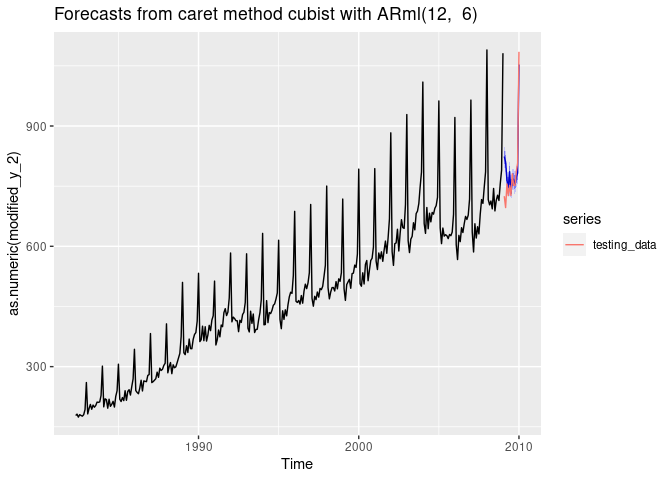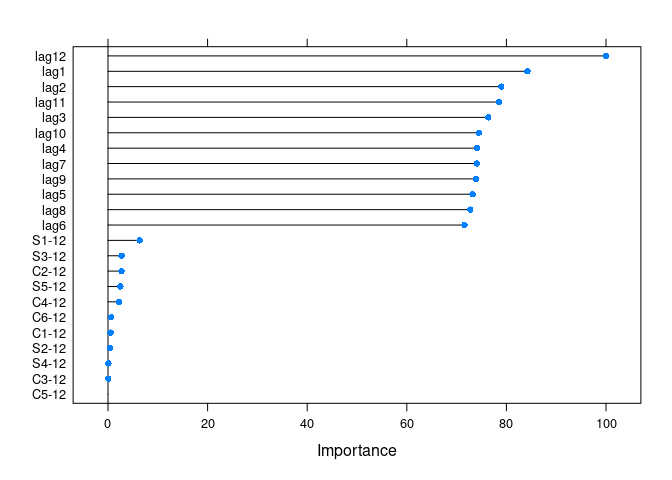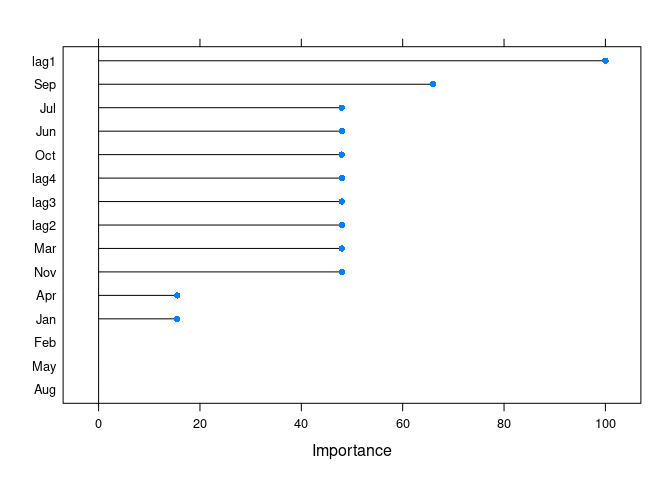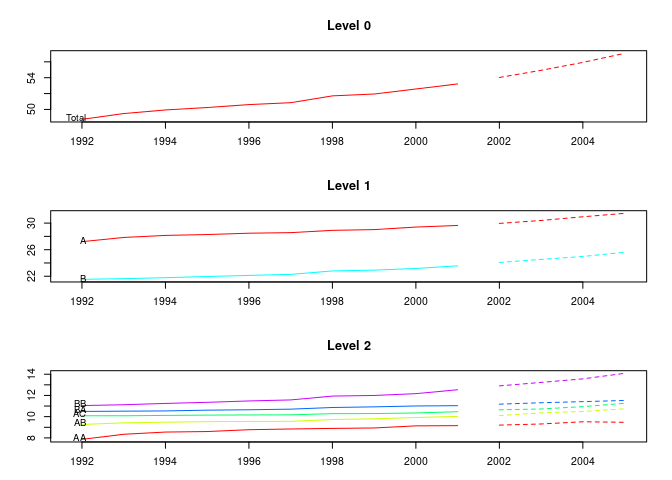
caretForecast aspires to equip users with the means of using machine learning algorithms for time series data forecasting.
The CRAN version with:
install.packages("caretForecast")The development version from GitHub with:
# install.packages("devtools")
devtools::install_github("Akai01/caretForecast")By using caretForecast, users can train any regression model that is compatible with the caret package. This allows them to use any machine learning model they need in order to solve specific problems, as shown by the examples below.
library(caretForecast)
#> Registered S3 method overwritten by 'quantmod':
#> method from
#> as.zoo.data.frame zoo
data(retail_wide, package = "caretForecast")i <- 8
dtlist <- caretForecast::split_ts(retail_wide[,i], test_size = 12)
training_data <- dtlist$train
testing_data <- dtlist$test
fit <- ARml(training_data, max_lag = 12, caret_method = "glmboost",
verbose = FALSE)
#> initial_window = NULL. Setting initial_window = 301
#> Loading required package: ggplot2
#> Loading required package: lattice
forecast(fit, h = length(testing_data), level = c(80,95))-> fc
accuracy(fc, testing_data)
#> ME RMSE MAE MPE MAPE MASE
#> Training set 1.899361e-14 16.55233 11.98019 -1.132477 6.137096 0.777379
#> Test set 7.472114e+00 21.68302 18.33423 2.780723 5.876433 1.189685
#> ACF1 Theil's U
#> Training set 0.6181425 NA
#> Test set 0.3849258 0.8078558
autoplot(fc) +
autolayer(testing_data, series = "testing_data")
i <- 9
dtlist <- caretForecast::split_ts(retail_wide[,i], test_size = 12)
training_data <- dtlist$train
testing_data <- dtlist$test
fit <- ARml(training_data, max_lag = 12, caret_method = "cubist",
verbose = FALSE)
#> initial_window = NULL. Setting initial_window = 301
forecast(fit, h = length(testing_data), level = c(80,95), PI = TRUE)-> fc
accuracy(fc, testing_data)
#> ME RMSE MAE MPE MAPE MASE
#> Training set 0.5498926 13.33516 10.36501 0.0394589 2.223005 0.3454108
#> Test set -17.9231242 47.13871 32.03537 -2.6737257 4.271373 1.0675691
#> ACF1 Theil's U
#> Training set 0.3979153 NA
#> Test set 0.4934659 0.4736043
autoplot(fc) +
autolayer(testing_data, series = "testing_data")
i <- 9
dtlist <- caretForecast::split_ts(retail_wide[,i], test_size = 12)
training_data <- dtlist$train
testing_data <- dtlist$test
fit <- ARml(training_data, max_lag = 12, caret_method = "svmLinear2",
verbose = FALSE, pre_process = c("scale", "center"))
#> initial_window = NULL. Setting initial_window = 301
forecast(fit, h = length(testing_data), level = c(80,95), PI = TRUE)-> fc
accuracy(fc, testing_data)
#> ME RMSE MAE MPE MAPE MASE
#> Training set -0.2227708 22.66741 17.16009 -0.2476916 3.712496 0.5718548
#> Test set -1.4732653 28.47932 22.92438 -0.4787467 2.883937 0.7639481
#> ACF1 Theil's U
#> Training set 0.3290937 NA
#> Test set 0.3863955 0.3137822
autoplot(fc) +
autolayer(testing_data, series = "testing_data")
get_var_imp(fc)
get_var_imp(fc, plot = F)
#> loess r-squared variable importance
#>
#> only 20 most important variables shown (out of 23)
#>
#> Overall
#> lag12 100.0000
#> lag1 83.9153
#> lag11 80.4644
#> lag2 79.9170
#> lag3 79.5019
#> lag4 78.3472
#> lag9 78.1634
#> lag5 78.0262
#> lag7 77.9153
#> lag8 76.7721
#> lag10 76.4275
#> lag6 75.7056
#> S1-12 3.8169
#> S3-12 2.4230
#> C2-12 2.1863
#> S5-12 2.1154
#> C4-12 1.9426
#> C1-12 0.5974
#> C6-12 0.3883
#> S2-12 0.2220
i <- 8
dtlist <- caretForecast::split_ts(retail_wide[,i], test_size = 12)
training_data <- dtlist$train
testing_data <- dtlist$test
fit <- ARml(training_data, max_lag = 12, caret_method = "ridge",
verbose = FALSE)
#> initial_window = NULL. Setting initial_window = 301
forecast(fit, h = length(testing_data), level = c(80,95), PI = TRUE)-> fc
accuracy(fc, testing_data)
#> ME RMSE MAE MPE MAPE MASE
#> Training set 7.11464e-14 12.69082 9.53269 -0.1991292 5.212444 0.6185639
#> Test set 1.52445e+00 14.45469 12.04357 0.6431543 3.880894 0.7814914
#> ACF1 Theil's U
#> Training set 0.2598784 NA
#> Test set 0.3463574 0.5056792
autoplot(fc) +
autolayer(testing_data, series = "testing_data")
get_var_imp(fc)
get_var_imp(fc, plot = F)
#> loess r-squared variable importance
#>
#> only 20 most important variables shown (out of 23)
#>
#> Overall
#> lag12 100.0000
#> lag1 84.2313
#> lag2 78.9566
#> lag11 78.5354
#> lag3 76.3480
#> lag10 74.4727
#> lag4 74.1330
#> lag7 74.0737
#> lag9 73.9113
#> lag5 73.2040
#> lag8 72.7224
#> lag6 71.5713
#> S1-12 6.3658
#> S3-12 2.7341
#> C2-12 2.7125
#> S5-12 2.4858
#> C4-12 2.2137
#> C6-12 0.6381
#> C1-12 0.5176
#> S2-12 0.4464The xreg argument can be used for adding promotions, holidays, and other external variables to the model. In the example below, we will add seasonal dummies to the model. We set the ‘seasonal = FALSE’ to avoid adding the Fourier series to the model together with seasonal dummies.
xreg_train <- forecast::seasonaldummy(AirPassengers)
newxreg <- forecast::seasonaldummy(AirPassengers, h = 21)
fit <- ARml(AirPassengers, max_lag = 4, caret_method = "cubist",
seasonal = FALSE, xreg = xreg_train, verbose = FALSE)
#> initial_window = NULL. Setting initial_window = 132
fc <- forecast(fit, h = 12, level = c(80, 95, 99), xreg = newxreg)
autoplot(fc)
get_var_imp(fc)
library(hts)
data("htseg1", package = "hts")
fc <- forecast(htseg1, h = 4, FUN = caretForecast::ARml,
caret_method = "ridge", verbose = FALSE)
plot(fc)